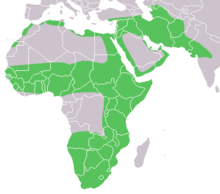
Appearance
A caracal hunting
The caracal is the largest of Africa's "small cats."[4] Males can weigh up to 18 kilograms (40 lb), and females up to 16 kilograms (35 lb). Caracals are about 40 centimetres (16 in) to 50 centimetres (20 in) tall at the shoulder. Caracals have a short tail. The male and female look the same. Its eye pupils shrink to circles, while other cats' pupils shrink to slits.[4]
Evolution and taxonomy
The caracal is most closely related to the African golden cat (Caracal aurata),[5] and likely diverged from the serval lineage within the last 5 million years, around the split between the Pliocene and Pleistocene eras.[6] In the past, the caracal was classified with either the Lynx[2] or Felis genera. However, recent molecular evidence now supports a monophyletic genus.[1]Behavior
Caracals are nocturnal hunters. They are normally solitary animals, but some live in pairs. Social interactions usually occur only during mating. Caracals can purr, hiss, snarl, bark and growl. The caracal breeds throughout the year. Females have from one to six kittens per litter. The kittens become independent after about nine or ten months. The young then travel considerable distances to find and claim their own new territory. Females normally have one litter per year. In captivity, a caracal can live up to 16 years; in the wild, they live for 10 to 12 years. Females stay in one place to defend the territory, while males roam over larger areas. Both genders leave scent marks. The caracal's speed and agility makes them very good hunters; they are able to take down prey two to three times their size.[1] Their powerful hind legs allow them to leap more than three metres (9.8 ft) into the air to catch birds on the wing.[7] Caracals are primarily nocturnal, and occasionally arboreal although they usually stay on the ground.[6]Distribution and habitat

The caracal inhabits woodlands, savannas, semi-deserts, and scrub forests, and prefers arid habitats with lower rainfall and some coverage.[1] Although it hunts on the ground, it can climb trees and swim swiftly to catch fish. They are not found in tropical rainforests.[1] However, they will inhabit evergreen and montane forests.[4]
The caracal is widely distributed across Africa, the Middle East, and Southwest Asia into India. This small cat is distributed across all of Africa except for the equatorial forest belt and the central Sahara. The historical range of the caracal is similar to that of the cheetah; both overlap with the range of several small desert gazelles. However, the caracal remains today in a wider range. The caracal has remained in most of its historical range, although has lost a part of its range at the edges, especially in North and West Africa.[1]
Female home ranges are smaller than male home ranges. In general, caracal home ranges are larger in arid environments compared to areas with more water.[1]
Reproduction
The caracal's gestation period is approximately two and a half months, and litters are usually between one and four kittens.[8] The kittens are weaned by 10 weeks, but remain with the mother for up to a year. Caracals reach sexual maturity between 12 and 16 months.[4]Diet
Like most carnivorous cats, the caracal has a very broad diet. It mainly consumes small mammals and birds. It also preys upon the young of larger mammals, such as the impala and antelope. Caracals sometimes eat lizards, snakes and insects.[1] The caracal preys on a variety of mammals, but most typically rodents, hares, hyraxes, and small antelope. Although caracals are considered a small cat, they do not hesitate to kill larger prey, such as an adult springbok or juvenile kudu, when the opportunity arises.[4] Hunting usually occurs at night and the caracal kills by biting the neck and suffocating its prey.[8] The caracal has also been known to scavenge when necessary.[1]Conservation
A caracal kitten
Captive breeding
Some zoos raise caracals in captive breeding programs. The ethics and safety of having a caracal as a pet are debated. Although they are easy to tame, caracals are very active and territorial.[11]
History
Caracals were historically trained to hunt birds in Iran and India. Sometimes, a caracal was put into a stadium along with a flock of pigeons. People would make bets on how many pigeons the caracal would kill during a set time span. A well-trained caracal could take down up to twelve pigeons in one leap with its large paws and strong legs.[12] This is where the expression "to put a cat amongst the pigeons" came from.[4]
Cultural depictions
Caracals appear to have been religiously significant to the ancient Egyptians. Caracals were found in wall paintings, and sculptures of caracals and other cats guarded tombs. Some caracal bodies were embalmed.[13]Like cheetahs, caracals were used as a hunting tool. Caracals were trained to hunt small game and birds for Indian royalty.[1] Today, many people consider the caracal an "exotic" pet, although they do not behave domestically in captivity. Despite its wild attitude, attempts have been made to crossbreed caracals with domestic cats to produce a "domestic" caracal.[4]


No comments:
Post a Comment
Note: Only a member of this blog may post a comment.